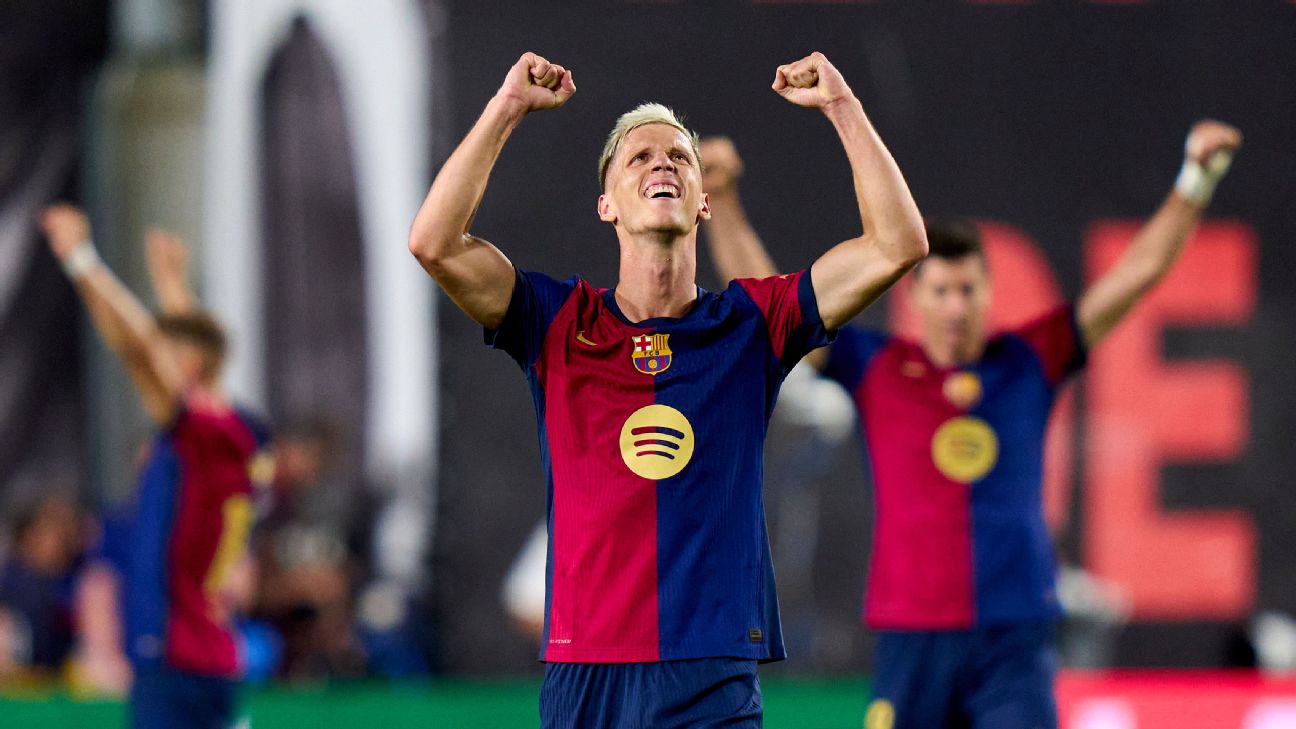In soccer, the best predictions are typically also the most boring ones. The clubs with the most money have the best players, and the teams with the best players do the best over the course of a long league season. The most likely league champions in Europe’s biggest leagues, per your sportsbook or soccer rating of choice? Probably Manchester City (the winner of six of the past seven Premier League titles), Bayern Munich (11 of 12 Bundesliga titles), Real Madrid (three of five LaLiga titles and five of nine Champions Leagues), Paris Saint-Germain (10 of 12 Ligue 1 titles) and Inter Milan (two of four Serie A titles and two of three Coppa Italias). What fun is there in predicting any of those teams?
It’s a lot more fun to take tiny morsels of interesting information and run with them. Granted, even that can lead us to picking favorites sometimes — what part of “Manchester City, Arsenal and Liverpool win their first six matches by a combined 14-1” leads you to believe anyone else has even a sliver of a shot of cracking the top three in England, for instance? But even in the Premier League, we’ve seen some early surprises through two matchdays.
For each of the past two years, I’ve shared a set of early-season August overreactions. As you would expect, that results in quite a few misses of the “Valencia and Brighton will make the Champions League” variety. But other times, the opening hours of the season really can give you a glimpse into something real, “Bayer Leverkusen will win the Bundesliga in 2023-24” or “Jude Bellingham will lead Real Madrid in scoring (despite being a midfielder),” for instance, or “Union Berlin will make the Champions League.”
Acknowledging that we’re going to whiff pretty badly on a few of these, it’s time to take some swings!
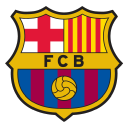 Barcelona will win LaLiga this season
Barcelona will win LaLiga this season
This isn’t exactly the biggest risk in the world; after all, Barca have won nine of the past 16 league titles in Spain, and they won it as recently as 15 months ago. But considering their main rival, Real Madrid, won both LaLiga and the Champions League last season, then signed one of the few true “best player in the world” candidates (Kylian Mbappé), while Barca have continued to careen from one irresponsible financial decision to another and just went through one of the silliest managerial sagas you’ll ever see, it’s safe to say Real Madrid were the obvious choice to win the league again this year.
Despite themselves, however, they indeed made a pretty clear managerial upgrade, flipping from club legend Xavi to 2020 Champions League winner Hansi Flick, and through Barcelona’s first three matches there’s not even a slight question as to who’s been the best team in Spain.
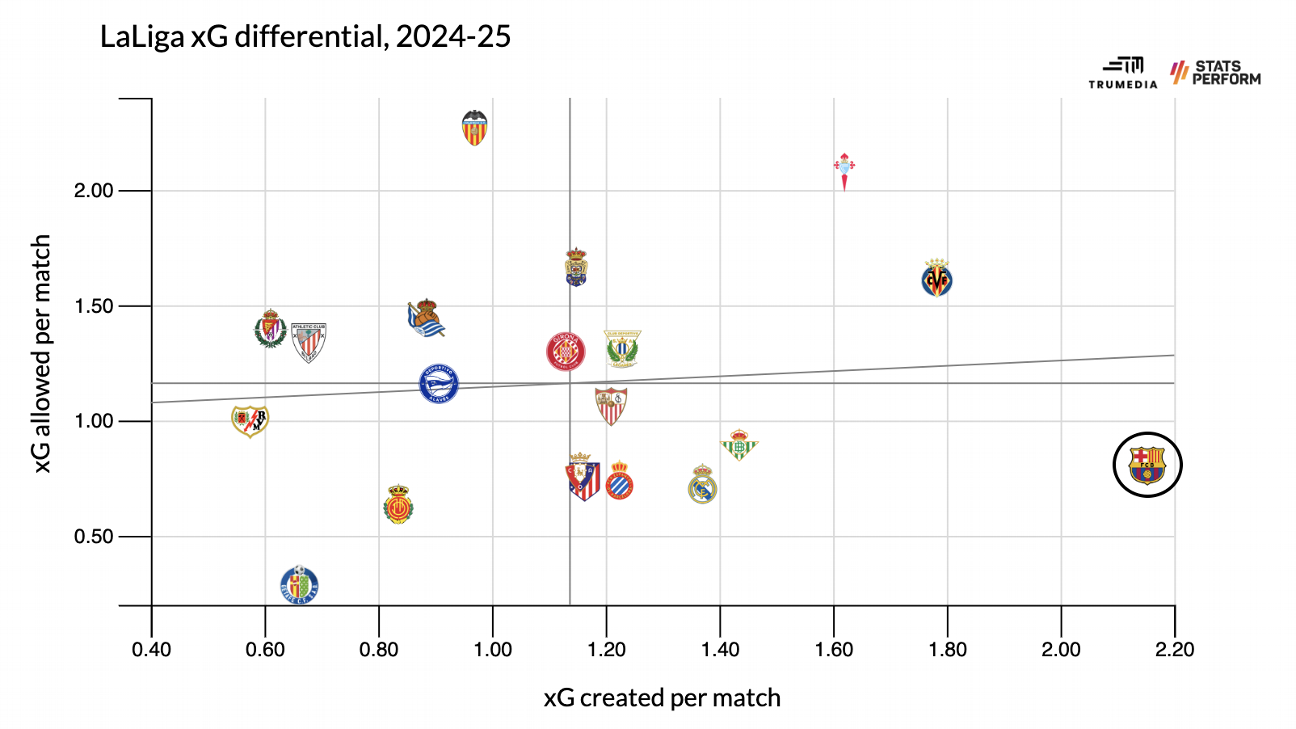 (Source: TruMedia)
(Source: TruMedia)
So far, Barca are allowing shots worth 0.8 expected goals per match (down from last season’s 1.1) and attempting shots worth a league-best 2.2 (up from 2.1). Flick has moved from Xavi’s 4-3-3 formation to more of a 4-2-3-1, with Raphinha moving to a central attacking role behind forward Robert Lewandowski. That’s certainly kept the Barca attack at an appropriately high level — Lewandowski has three goals from shots worth 3.2 xG (he’s averaging a lofty 0.23 xG per non-penalty shot), and right winger/Euro 2024 star Lamine Yamal is doing Lamine Yamal things with a goal and two assists — but Raphinha’s energy levels up front have also done a solid job of setting up a solid press. Barca have already scored five goals from high turnovers (second in the league) and have jumped from forcing 42.2 high turnovers per match to 47.0 (fourth).
In the early going, they’re nicely balancing Barca-style possession with a dose of risk and aggression, and they’ve done so despite a juggled/muddled midfield. Marc Casadó, 20, started the first match over Pedri (who was still working his way back to fitness), and Marc Bernal, 17, the latest great La Masia midfield product, just became the latest great La Masia midfield product to suffer a knee injury (ACL).
Real Madrid, meanwhile, have alternated between moments of brilliance and tepid play; granted, that’s what they always do, but the ratio has been off. They suffered a 1-1 draw with Mallorca in the opener and labored through a scoreless first half with Real Valladolid before hitting the gas. In the UEFA Super Cup, they did the same thing, barely breaking even against Atalanta before figuring things out. They’ve created few high-value opportunities (10th in xG per shot), and aside from counterattacking situations, they’ve just looked stodgy.
It was perhaps always going to take Real Madrid a little while to create chemistry up front with Mbappé joining the attack, but while they’re figuring that out, Barca could put a pretty big point total on the board.
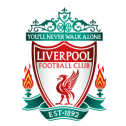 Liverpool: back in the top 2
Liverpool: back in the top 2
Arsenal gutted out a solid 2-0 win over Aston Villa last weekend; it was a match that could have turned out quite differently had Villa’s brilliant Ollie Watkins been more clinical in two high-value attempts — he missed a great transition opportunity in the 24th minute, then had an even better chance brilliantly saved by David Raya in the 55th — but once they had dodged danger, they put the match away with goals in the 67th and 77th minutes. They’ve kept pace with Manchester City so far with a pair of 2-0 wins.
Liverpool have enjoyed a pair of 2-0s as well, and against lesser competition (Brentford and poor Ipswich). So if Arsenal’s created the scoreline against better opponents, that means they’ve been the better team, right? Not necessarily.
Liverpool have attempted shots worth 5.7 xG (first in the Premier League) and given opponents shots worth only 0.8 (also first). They’ve been relatively unlucky in the finishing department, with Diogo Jota and Luis Díaz scoring only twice from shots worth 2.9 xG and no one else besides Mohamed Salah being able to put one in the net yet. But if you’re creating the best chances and allowing the worst, you’re going to win a lot of matches. And that’s the case even if you haven’t played an awesome team yet.
 (Source: TruMedia)
(Source: TruMedia)
The above chart shows us each team’s xG differential on the X axis and their opponents’ average Opta power ratings on the Y axis. If you’re above the trend line, it means you’ve performed above what is expected based on your opponents’ quality.
Liverpool and Manchester City are above the trend line (and Chelsea’s pretty high above too, which is intriguing), but Newcastle and Tottenham Hotspur are well below the line — maybe a foreboding sign — and Arsenal’s a bit below as well. Clinical finishing is great but hard to maintain; opportunity creation is the most important thing over 38 matches, and Liverpool has mastered that early on. That Arne Slot has taken the aggression down a bit as Jurgen Klopp’s successor could eventually result in spells of aimless possession, but right now they’re taking opponents’ legs and then finishing them off with ease. Sunday’s match at Manchester United will tell us how well-prepared they are to do that against more talented opposition.
Luis Garcia reacts to Dani Olmo’s debut with Barcelona, in which Olmo scored the winning goal for the club.
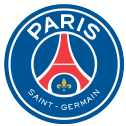 Paris Saint-Germain are better without Mbappé
Paris Saint-Germain are better without Mbappé
Here’s more from the “Creating better opportunities is a lot more reliable way to win than simply being clinical” department:
Last year, in a home match with Montpellier and a road match at Le Havre, PSG outscored their opponents 10-2 but did so while attempting shots worth 2.8 xG and allowing shots worth 4.5. Five of their goals were bombs from at least 18 meters away, and opponents attempted far more high-value shots (0.3 xG or more) than they did. That’s a tough recipe to maintain.
This season, in those same two fixtures, PSG outscored opponents by a similar 10-1 margin. But they did so from shot attempts worth 5.9 xG, and they allowed shots worth just 0.8 xG. They’ve gotten goals from seven different players and assists from five. Manager Luis Enrique has started 16 different guys in two matches — only four have played all 180 minutes thus far — and they’ve absolutely swamped opponents with depth and quality. They’ve created nine shots worth at least 0.2 xG and allowed none. They have nine assists, and no other Ligue 1 team has more than three.
We’ve come to expect that, of course. Even with media rights revenue plummeting and driving proud clubs such as Bordeaux to ruin, PSG remain one of the richest clubs in Europe thanks to the checkbook of Qatar Sports Investments. They have indeed won 10 of the past 12 league titles — most of those with relative ease — so comparing one dominant team to another is awfully hard. But from an xG perspective, they’ve rarely been as dominant as they’ve been in the first two matches of 2024-25, and that’s noteworthy considering they lost Mbappé over the summer.
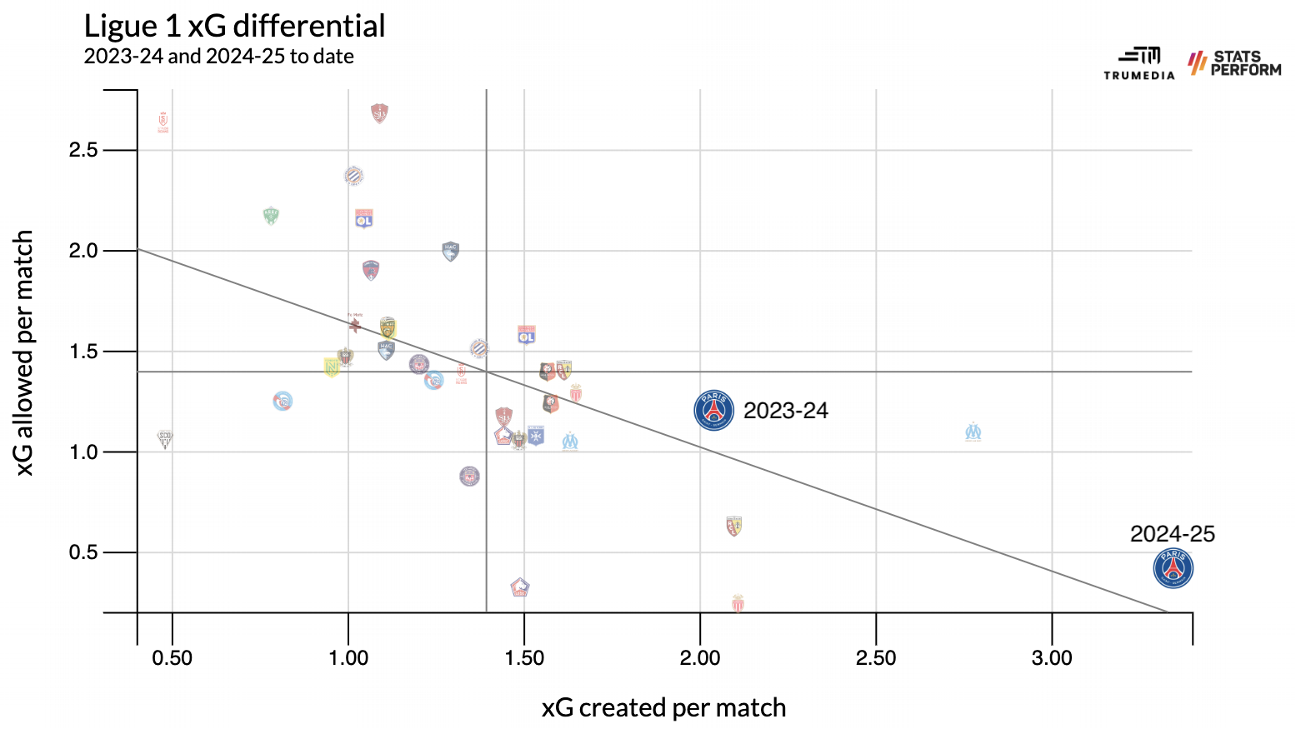 (Source: TruMedia)
(Source: TruMedia)
Honestly, PSG look and feel far more like a Luis Enrique team this season. With Mbappé up front, you are basically forced to play a certain way. He doesn’t press and he’s best in counterattacking situations, while Luis Enrique-led teams love to press high and dominate the pitch. And with players such as Gonçalo Ramos (pre-injury) and Randal Kolo Muani taking Mbappé’s place up front and an endless supply of wingers — Ousmane Dembélé, Bradley Barcola, Lee Kang-in, newly acquired teenage sensation Désiré Doué — PSG are just running more and overwhelming opponents. They’re allowing fewer passes per defensive action (8.79 in 2023-24, 8.17 in 2024-25), creating more high turnovers (from 42.3 to 46.0), dominating field position (from starting possessions 2.6 meters further up the pitch than opponents to 8.9) and starting more possessions in the attacking third (from 9.7% to 11.5%). And while they ranked first in field tilt last season (69.0% of all passes in the attacking third), they’re at a suffocating 86.3% this season.
Marseille have also looked awesome so far this season (you can see a tiny Marseille logo pretty far out to the right on the above chart), but PSG are exploring new realms of dominance early this season, and they’re doing it without one of the best attackers in the world.
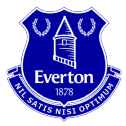 Everton: going down, down, down
Everton: going down, down, down
In spring 2017, things fell into place for Werder Bremen, and just in the nick of time. They had pulled just seven points in 11 matches to start the season — including losses by a combined 12-2 in the first three — and suffered a shocking loss to lower-division Sportfreunde Lotte (literally “sport friends of Lotte,” a town of about 14,000) in the DFB-Pokal as well. They were still mired in the relegation zone under new manager Alexander Nouri in mid-February, but led by a hot streak from striker Max Kruse, they ripped off an 11-match unbeaten streak that saved the season and damn near snagged a spot in a European competition.
Werder Bremen are now the model for Everton. Since 2011-12, only seven teams in Europe’s Big Five leagues have begun the season with two losses by a combined seven goals or more, including 2024-25 Everton. Bremen are the only one that survived relegation. The last three to do so finished in last place.
Two losses and a goal differential of minus-7 or worse through two matches, Big Five leagues since 2011-12:
• 2011-12 Koln (finished second-last in the Bundesliga, relegated)
• 2014-15 Evian TG (finished third-last in Ligue 1, relegated)
• 2016-17 Werder Bremen (finished eighth in the Bundesliga)
• 2018-19 Huddersfield (finished last in the Premier League, relegated)
• 2020-21 Schalke (finished last in the Bundesliga, relegated)
• 2021-22 Norwich City (finished last in the Premier League, relegated)
• 2024-25 Everton (TBD)
Despite a point deduction that kept them hovering near the relegation zone for much of the season, Everton were decidedly decent in 2023-24, and despite losing midfielder Amadou Onana to Aston Villa and dealing with a dire ownership situation, they began a respectable 13th in our preseason EPL power rankings. But they couldn’t possibly have begun this season in worse fashion.
Granted, starting the 2024-25 campaign with Brighton and Tottenham Hotspur was a challenge, but they were outscored 7-0 with the second-worst xG differential in the league. Everton rank 19th in shots per possession and 17th in xG allowed per shot. Despite Sean Dyche’s counterattacking bona fides, they rank 17th in xG created from counterattacks and 20th in xG allowed from them. They’ve put just 10.5% of their shots on target (a distant last place) and created the third-fewest high turnovers while committing the ninth-most. Forwards Dominic Calvert-Lewin and Beto have combined for one shot attempt worth 0.05 xG. Nothing has even slightly worked.
It’s still August, but Saturday’s home match against Bournemouth already feels like a must-win — or at least a must-show-something — match.
 Juventus will win Serie A
Juventus will win Serie A
Granted, I said this in last year’s piece as well following Juve’s 3-0 opening-day win, and it didn’t come to fruition. But they still improved from seventh to third in Serie A and won the Coppa Italia for the first time in three years before making what appears to be a major upgrade at manager, hiring Thiago Motta after he led Bologna to its best finish in 52 years.
They’ve attempted upgrades at both midfield (adding Douglas Luiz and Khephren Thuram) and in attack (adding wingers Nico Gonzalez and Francisco Conceição on loan-to-buy deals), but Motta hasn’t even needed those newcomers yet: those four newcomers have played just 33 combined minutes, but Juve have still opened the new season with matching 3-0 wins over Hellas Verona and Como.
Motta’s Bologna succeeded with a combination of safe and sturdy buildup play, defensive solidity and occasional offense — that’s the formula Juve have relied on so far as well. They’ve allowed only 10 shot attempts in two matches (fewest in the league) and have blocked 70% of them (most). They’re completing 90.1% of their passes (first), and they lead the league with nine buildup attacks (sequences with 10 or more passes that end in a shot or a box touch). They’re drastically overachieving their xG totals — those six goals have come from shots worth just 2.4 xG — but they’re also creating opportunities between the posts, and they’ve had only 9.5% of their shots blocked thus far (fewest in the league).
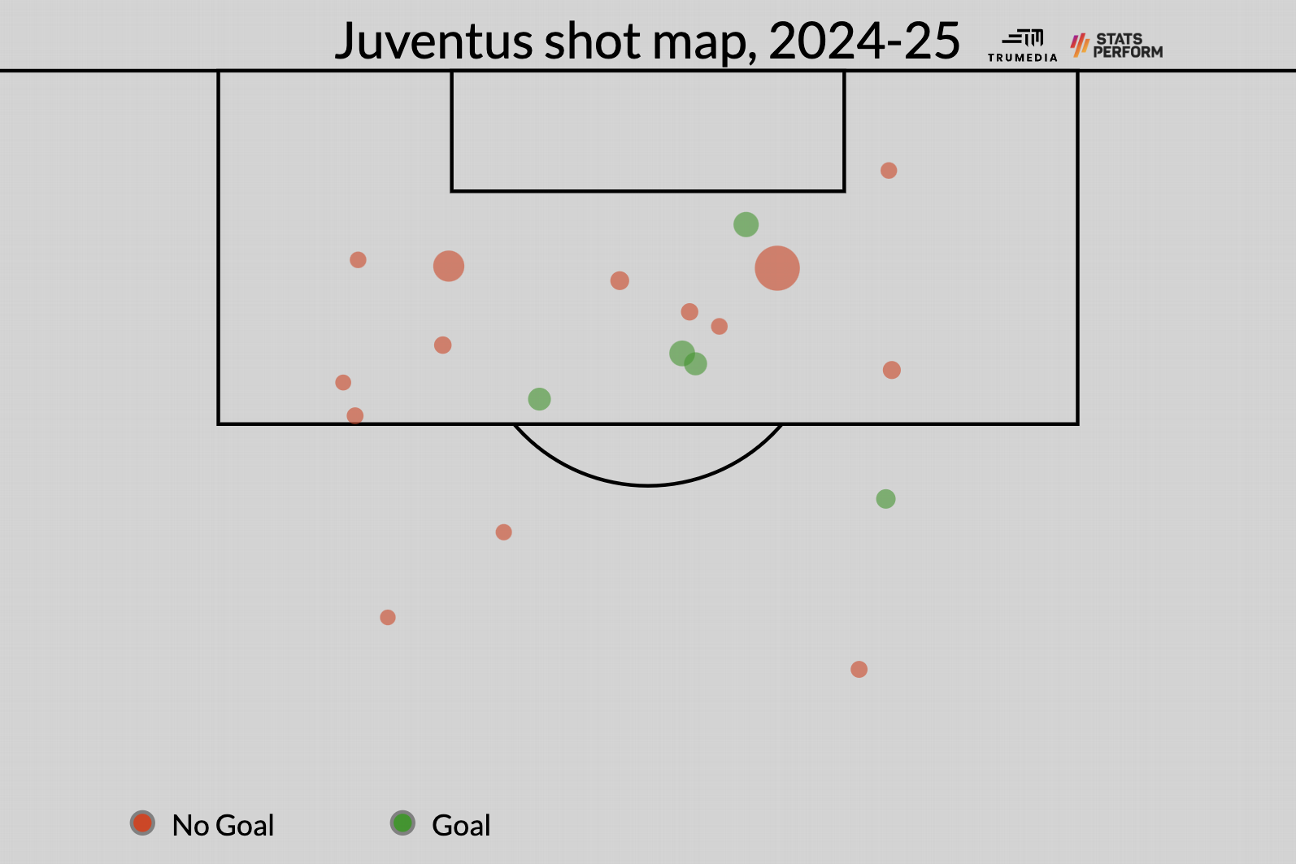 (Source: TruMedia)
(Source: TruMedia)
If you play old-school, “sticky” Juventus defense, wear down opponents’ legs with constant possession and create occasional, unblockable shot attempts from the center of the pitch, you’re going to win a lot of matches.
The start of the Serie A season has been a bit odd, with an aging Inter squad dropping points against Genoa, AC Milan and Roma each pulling only one point from two matches, Atalanta losing to Torino, and Napoli losing 3-0 to Verona and making confusing roster moves (to put it diplomatically) off the pitch. Other potential contenders could eventually get their respective acts together, but Juve are already there, and they haven’t even gotten anything from their newcomers yet.
 Okay, THIS is the year Brighton break through
Okay, THIS is the year Brighton break through
Last year, after back-to-back 4-1 wins to start the season, I proclaimed Brighton a potential top-two team. That … didn’t happen. After five wins in their first six games (all by multiple goals), a combination of injuries, a souring managerial relationship (goodbye, Roberto De Zerbi) and plain old regression to the mean took hold, and the Seagulls won just seven of their last 32 league matches to finish 11th.
After another tiny sample, I’m proudly stepping on the rake again. Brighton began 2024-25 by pummeling Everton 3-0 and outlasting Manchester United 2-1 with a late João Pedro winner. They’re second in goal differential and fourth in xG differential, and under first-year manager Fabian Hurzeler they are, like Barca, combining possession and risk in a fun way. They’re seventh in possession rate (54.4%), fifth in total pass attempts and fourth in progressive carries — all fundamental traits of a possession-hungry team — but they’re also fifth in direct speed, which measures how quickly a team moves the ball up the pitch in possession. And they’ve got two of the most delightful ball progressors in the league.
Kaoru Mitoma was a big reason for the 2023-24 optimism, but he missed most of the second half of the season — the bad half — with first an ankle injury, then a back injury. Now healthy, the 27-year old has been awesome and particularly aggressive to start the season. He’s one of only two players in the league with 15 progressive carries, 10 1v1 attempts and at least 1.5 combined expected goals (xG) and assists (xA). The other is a pretty good attacking role model: Tottenham Hotspur’s Son Heung-min.
Brighton’s other main difference-maker was a product of profit and sustainability. With Newcastle needing to knock out a couple of sales in June to adhere to profit and sustainability rules, Brighton, one of the more openly responsible Premier League teams from a spending perspective, swooped in and nabbed 20-year-old attacking midfielder Yankuba Minteh. And despite missing 47 minutes in the first match because of injury, he’s currently first in the Premier League in Stats Perform’s expected point value added measure (xPVA, which basically looks at every action that increases a team’s likelihood of scoring). He’s first on the team in chances created (five) and second, behind only Mitoma, in 1v1 attempts.
Hurzeler is only 31 — fully seven years younger than Brighton midfielder James Milner. He pulled off an immediate and ferocious turnaround at St. Pauli and got them promoted to the Bundesliga last season; as early as it might be, he’s pushing the right divs so far in the vegan capital of England as well.
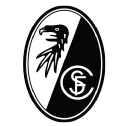 Freiburg will end up back in the Bundesliga top five
Freiburg will end up back in the Bundesliga top five
In two of three matches this season, Stuttgart has looked the part of a team that has no interest in leaving the Bundesliga’s top four. After a shocking second-place finish in 2023-24, they’ve already fought Bayer Leverkusen to a draw (before losing in penalties) in Germany’s Super Cup and beaten second-division Preussen Munster to a pulp, 5-0, in the DFB-Pokal.
In between, however, they got completely outclassed by Freiburg.
After giving up a brilliant goal in the second minute, Freiburg dominated, finishing with three goals from 16 shots worth 2.8 xG. (Stuttgart: one from eight shots worth 0.4.) They weathered an early storm, then tilted the pitch dramatically in their favor for more than an hour.
 (Source: TruMedia)
(Source: TruMedia)
(A momentum chart looks at which team created the higher possession value for each minute of the match, and as you see, Freiburg created most of the value between the 10- and 70-minute marks of the match.)
Freiburg scored from long range and short range, they prevented Stuttgart from creating any shots worth more than 0.08 xG, they pressed selectively but perfectly, turning high turnovers into two goals, and under new manager Julian Schuster, a longtime player and assistant under legendary Freiburg manager Christian Streich, they basically looked like a new-and-improved version of Streich’s Freiburg.
It’s harder than usual for an underdog to hold major ambition in the Bundesliga at the moment, with each of the league’s current four major clubs — Bayern Munich, defending champion Bayer Leverkusen, defending Champions League finalist Borussia Dortmund and RB Leipzig — looking the part. But before slipping to 10th last season, Freiburg finished fifth in 2022-23 and sixth in 2021-22. Vincenzo Grifo remains one of the league’s best passers and set-piece takers, veteran fullbacks Lukas Kübler and Christian Günter remain as good as ever, and Ritsu Doan, a steady contributor for a couple of years (and a hero of Japan’s 2022 World Cup campaign), was brilliant on Saturday. Nothing about what they did to Stuttgart looked out of character. They could be a threat to climb into the top five, potentially past Stuttgart.
 Say it out loud: Top-10 Nottingham Forest?
Say it out loud: Top-10 Nottingham Forest?
From one of my contributions to the Premier League mega-preview:
“After Nuno Espirito Santo’s hire on Dec. 20, Nottingham Forest ranked first in xG differential on counterattacks and fifth in overall xG differential. But between a point deduction and appalling goalkeeping, they spent most of the season in the relegation fight.”
Espirito Santo inherited lovely counterattacking personnel in Nottingham and knew what to do with it. With even average goalkeeping, this team had top-half-of-the-table potential. (Unfortunately, their goalkeeping was far less than average.)
So far in 2024-25, Matz Sels has been solid in goal (80% save percentage, one goal allowed from on-goal attempts worth 1.2 postshot xG), and Forest have four points from two matches. They’re up to third in xG differential, and while they’ve only played Southampton on the road and Bournemouth at home, hey, last season they lost at home to Bournemouth. They’re attempting a ton of shots and allowing very few, and that will take you pretty far.
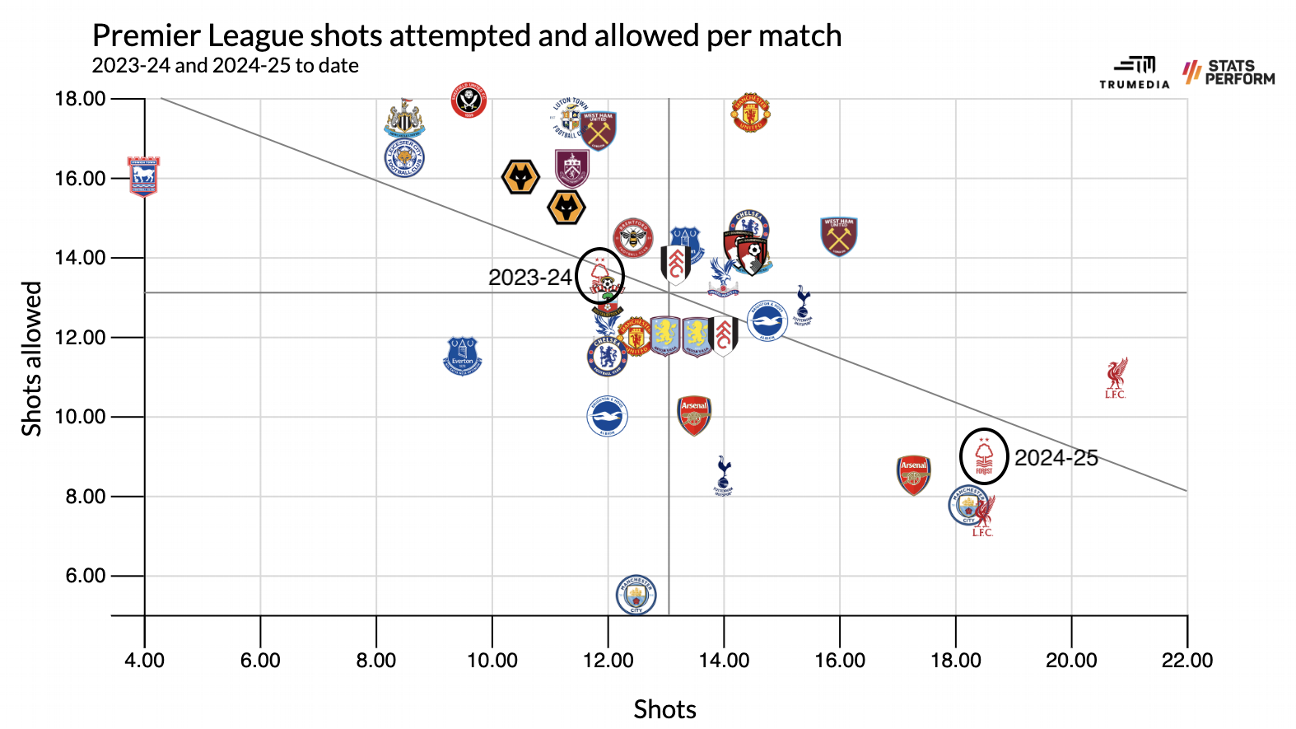 (Source: TruMedia)
(Source: TruMedia)
Forest have scored only twice, but they’ve attempted 37 shots (most in the league) worth 3.8 xG (fifth), and each of the attacking midfield trio of Morgan Gibbs-White, Callum Hudson-Odoi and Anthony Elanga is on pace for over 90 chances created. I’m not going to pretend this is a potential top-four team or anything, but a first top-10 Premier League finish in 29 seasons? Why not?
